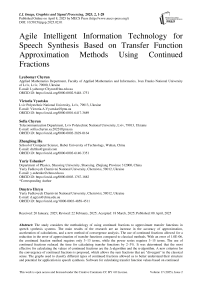Agile Intelligent Information Technology for Speech Synthesis Based on Transfer Function Approximation Methods Using Continued Fractions
Автор: Lyubomyr Chyrun., Victoria Vysotska., Sofia Chyrun., Zhengbing Hu., Yuriy Ushenko, Dmytro Uhryn
Журнал: International Journal of Image, Graphics and Signal Processing @ijigsp
Статья в выпуске: 2 vol.17, 2025 года.
Бесплатный доступ
The study considers the methodology of using continued fractions to approximate transfer functions in speech synthesis systems. The main results of the research are an increase in the accuracy of approximation, acceleration of calculations, and a new method of convergence analysis. The use of continued fractions allowed for a reduction in the error of approximation of transfer functions compared to classical methods. With an error of 1.0E-06, the continued fraction method requires only 3–13 terms, while the power series requires 3–15 terms. The use of continued fractions reduced the time for calculating transfer functions by 2–3%. It was determined that the most effective for calculating the values of continued fractions are the Δ-algorithm and the α-algorithm. A new criterion for the convergence of continued fractions is proposed, which allows the sum fractions that are "divergent" in the classical sense. The graphs used to classify different types of continued fractions allowed us to better understand their structure and potential for application in speech synthesis. Software for calculating transfer function values based on continued fraction decomposition has been developed and tested. It has allowed automation of the approximation process and increased the efficiency of speech synthesis systems. The results obtained have allowed improving the quality of synthesised speech while simultaneously reducing the complexity of calculations. Systems using continued fractions consume less memory and provide more accurate voice reproduction. In summary, the work presents a new approach to the approximation of transfer functions, which is essential for optimising speech synthesis systems.
Text-To-Speech, NLP, Speech Recognition, Continued Fractions, Speech Recognition Systems, Speech Synthesis Systems, Autoregressive Modelling, Formant Synthesis, Continued Fraction Approximation
Короткий адрес: https://sciup.org/15019713
IDR: 15019713 | DOI: 10.5815/ijigsp.2025.02.01


